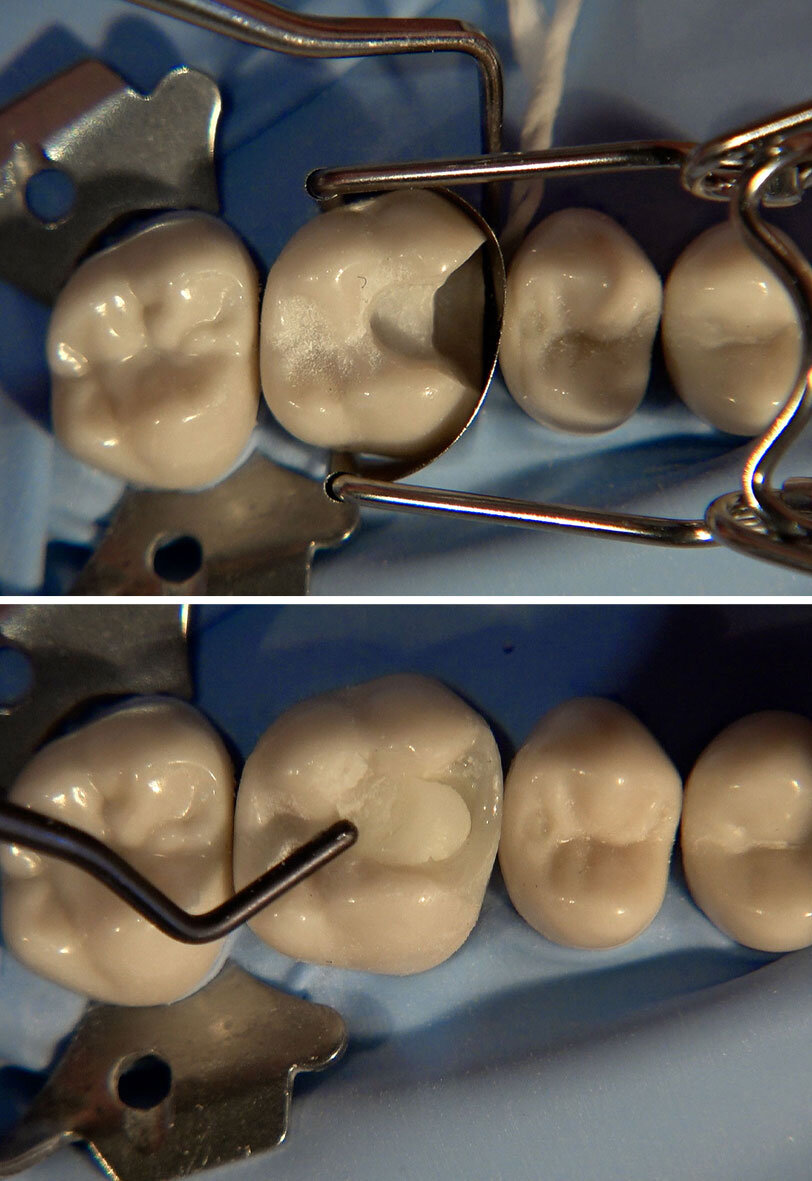Quintessence International, 1/2022
DOI: 10.3290/j.qi.b2091331, PubMed-ID: 34595910Seiten: 90-102, Sprache: EnglischSaratti, Carlo Massimo / Rocca, Giovanni Tommaso / Vaucher, Paul / Awai, Lea / Papini, Andrea / Zuber, Sascha / Di Bella, Enrico / Dietschi, Didier / Krejci, IvoObjectives: To review the dynamic analytical elements used in the functional assessment of the stomatognathic system, summarize the available scientific evidence, and consider interrelations with body posture and cognition.
Method and materials: A thorough literature search was conducted using PubMed, the Cochrane Library database, and Google Scholar. Peer-reviewed articles and literature reviews provided up-to-date information addressing three topics: (a) the available knowledge and recent evidence on the relationship between the morphologic aspects of dental/craniofacial anatomy and oral function/dysfunction, (b) mandibular dynamics, considering mobility, functional activity, and existing methodologies of analysis, and (c) a possible correlation between the stomatognathic system, body posture, and cognition.
Results: Modern dentistry may be regarded as a human adaptation strategy, helping to conserve healthy teeth for much longer without risking overall health. It is futile to treat patients using a mechanistic, sectorial approach that misrepresents patient behavior and requests, just as it is to affirm the absence of any structure-function relationships. However, it is also evident that there is a lack of general consensus on the precise functional assessment of the stomatognathic system, mostly due to the methodologic heterogeneity employed and the high risk of bias. Despite the abundant evidence produced with the aim of providing solid arguments to define dynamic models of functional assessment of the stomatognathic system, it is yet to become highly empirical, based as it is on operator experience in daily clinical practice.
Conclusions: Further efforts from the scientific and clinical community, with the help of progress in technology, remain should this gap be filled and should substantial data on differences between pathologic and physiologic dynamic models of function be provided. Dentistry needs to employ – on a larger scale – objective, dynamic methods of analysis for the functional evaluation of the stomatognathic system, embracing concepts of “personalized medicine” and “interprofessional collaborations.”
Schlagwörter: cognition, kinesiography, mastication, neuroplasticity, oral function, posture
Quintessence International, 10/2021
DOI: 10.3290/j.qi.b2077573, PubMed-ID: 34595913Seiten: 920-932, Sprache: EnglischSaratti, Carlo Massimo / Rocca, Giovanni Tommaso / Vaucher, Paul / Awai, Lea / Papini, Andrea / Zuber, Sascha / Di Bella, Enrico / Dietschi, Didier / Krejci, IvoObjectives: To review the elements of static analysis in the functional assessment of the stomatognathic system, as promoted for more than a century by gnathologists, and summarize the available scientific evidence, including anthropologic observations.
Method and materials: A thorough search was conducted using PubMed, the Cochrane Library database, and Google Scholar. From peer-reviewed articles and other scientific literature, up-to-date information addressing three topics was identified: (a) the anthropologic perspective with particular consideration for the role of progressive dental wear over time, (b) descriptions of gnathologic principles and evidence on their scientific validity, and (c) the methodologic inaccuracies introduced by seeking to correlate variables directly rather than allowing for causal inference.
Results: For decades gnathology attempted to describe a structure-function correlation within the stomatognathic system by means of a model whose principles were static and mechanistic references. No scientific validation was ever achieved, placing clinical and research consensus out of reach.
Conclusions: A historical perspective helps to place the fundamentals of gnathology into context: They were conceived to solve technical difficulties but were then assumed to be physiologic stereotypes. This misconception led to a decades-long promotion of mechanistic theories to describe oral function, but the evidence available today supports a more flexible and adaptable approach. Gnathologic arguments have been relegated to become exclusively of technical relevance in oral rehabilitation.
Schlagwörter: dental occlusion, gnathology, oral function, real-world data, temporomandibular disorder, tooth wear
International Journal of Esthetic Dentistry (DE), 3/2020
Seiten: 256-276, Sprache: DeutschSaratti, Carlo Massimo / Merheb, Carl / Franchini, Leonardo / Rocca, Giovanni Tommaso / Krejci, IvoDie Entwicklung der digitalen Technik verändert die Zahnmedizin in zunehmendem Maß. Weil die CAD/ CAM-Systeme und dentalen Werkstoffe kontinuierlich verbessert werden, sind Behandlungspläne für Rehabilitationen mittlerweile mit vollständig digitalen und nicht invasiven Ansätzen ausführbar. Digitale Ressourcen erhöhen die Genauigkeit bei der Vorhersage des ästhetischen und funktionellen Behandlungsergebnisses. Inzwischen finden sich immer mehr Patienten, die von starker Zahnabnutzung betroffen sind und von solchen Behandlungskonzepten profitieren können. Der vorliegende Beitrag bietet die Schritt- für-Schritt- Dokumentation einer Gesamtrehabilitation, die im digitalen Workflow mit additiven CAD/CAM-Restaurationen aus Komposit realisiert wurde. Zudem wird eine innovative Form der Funktionsanalyse gezeigt und diskutiert. Die Ausgangssituation wurde analysiert und mithilfe einer Snap-on-Apparatur mit der Rehabilitationsplanung verglichen. Nach der intraoralen Anpassung und Bestätigung wurde die definitive Versorgung realisiert. Die am Provisorium gewonnenen Erkenntnisse wurden hierfür digital an das Labor übermittelt.
International Journal of Esthetic Dentistry (EN), 3/2020
PubMed-ID: 32760922Seiten: 242-262, Sprache: EnglischSaratti, Carlo Massimo / Merheb, Carl / Franchini, Leonardo / Rocca, Giovanni Tommaso / Krejci, IvoThe proliferation of digital technology is progressively changing dentistry. Thanks to continual improvements in CAD/CAM devices and dental materials, it is possible nowadays to carry out a treatment plan for oral rehabilitations with fully digital approaches and noninvasive concepts. The availability of digital resources allows clinicians to increase the predictability of enhanced esthetics and good functional results. There is an increasing number of patients today who are affected by excessive tooth wear and may benefit from these kinds of treatments. This article provides a step-by-step documentation of a full-mouth rehabilitation performed with a digital approach and additive CAD/CAM composite resin restorations. An innovative functional evaluation is also documented and discussed. The initial situation was assessed and compared with the rehabilitation project through a snap-on device. After the intraoral adjustment and validation, the final rehabilitation was performed according to the information obtained in the provisional phase and digitally transmitted to the laboratory.
International Journal of Esthetic Dentistry (DE), 3/2019
Seiten: 250-269, Sprache: DeutschDietschi, Didier / Shahidi, Cyrus / Krejci, IvoZiel: Ziele dieser Studie waren ein systematisches Review der Literatur zur klinischen Bewährung von direkten Kompositrestaurationen im Frontzahnbereich sowie die Bestimmung potenzieller Einflussfaktoren für den Erfolg und die Lebensdauer der Restauration.
Material und Methode: Die Suche umfasste alle in der PubMed-Datenbank, dem Cochrane Central Register of Controlled Trials und der Cochrane Library sowie in EMBASE gelisteten Studien bis 2016, eine Internetsuche mit Google (eventuell unter Einschluss nicht publizierter Daten), eine händische Suche (Bibliothek der Universität Genf) sowie die Durchsicht der Literaturverzeichnisse der relevanten Artikel. Eingeschlossen wurden Studien mit adäquatem Studienprotokoll und klarer Angabe von Daten zur Bewährung von Frontzahn-Kompositrestaurationen. Für jede Studie wurden ausgehend von den Überlebensraten die jährlichen Ausfallraten (JAR) berechnet. Bei fehlender Angabe zur Ausfallrate wurde die Indikation für eine Neuversorgung laut den USPHS-Scores (United States Public Health Service) verwendet. Der mögliche Einfluss folgender Faktoren wurde untersucht: Füllstofftyp des Komposits (mikro-, makro-, nanogefüllt oder hybrid), Polymerisationstyp (chemisch oder lichthärtend), Behandlungsumgebung (Hochschulklinik, private Praxis, Sozialklinik) und Behandleranzahl (einer oder mehrere). Die Studien wurden nach Beobachtungszeiträumen ( 2 Jahre, 2 bis 5 Jahre, > 5 Jahre) analysiert.
Ergebnisse: Insgesamt wurden 39 mögliche Studien gefunden, von denen 24 den Einschlusskriterien entsprachen: neun randomisierte Kontrollstudien, zwei prospektive Kontrollstudien, eine retrospektive Kontrollstudie, sechs prospektive Fallserien und vier retrospektive Fallserien.
Schlussfolgerung: Dieses Review folgte dem Standardvorgehen, verwendete aber einen alternativen Reviewprozess, um den deutlichen Datenverlust zu vermeiden, der mit der Methode der Metaanalyse verbunden ist. Insgesamt zeigen Kompositrestaurationen im Frontzahnbereich eine sehr heterogene Bewährung, wie sie in Reviews klinischer Studien häufig beobachtet wird. Dank der kritischen Auswertung konnten jedoch Einflussfaktoren, wie die Behandlungsumgebung und die Behandleranzahl, identifiziert werden.
International Journal of Esthetic Dentistry (EN), 3/2019
PubMed-ID: 31312812Seiten: 252-270, Sprache: EnglischDietschi, Didier / Shahidi, Cyrus / Krejci, IvoObjectives: The aim of this study was to systematically review the literature on the clinical behavior of direct anterior composite restorations and to identify the factors potentially influencing restoration success and longevity.
Materials and methods: The search included all existing references until September 2016 cited in the PubMed database, the Cochrane central register of controlled trials and Cochrane Library, EMBASE, an internet search using Google internet search engine (possibly including unpublished data), a hand search (University of Geneva library), and the perusal of the references of relevant articles. Studies with appropriate research protocols and that clearly reported data about the performance of anterior composite restorations were included. Yearly failure rates (YFRs) were computed for each study based on survival rates or, when not reported, using United States Public Health Service (USPHS) scores leading to reintervention. The potential impact of the following factors was evaluated: composite filler technology (microfilled, macrofilled, nanofilled or hybrid), polymerization mode (chemical or light cured), treatment environment (academic, private or social) and operator (single or multiple). The studies were analyzed according to the observation time ( 2 years, 2 to 5 years, and > 5 years).
Results: 39 potential studies were identified, from which 24 met the review inclusion criteria: nine randomized controlled trials (CTs), two prospective CTs, one retrospective CT, six prospective case series (CSs), and four retrospective CSs.
Conclusion: This review followed a standard approach and explored an alternative review process that limited the significant data loss that occurs when the meta-analysis method is used. Overall, anterior composite restorations have shown a large heterogeneity in performance, as is typically observed in reviews of clinical studies, but the present appraisal identified influential factors such as treatment environment and the number of operators.
Oral Health and Preventive Dentistry, 5/2018
DOI: 10.3290/j.ohpd.a41360, PubMed-ID: 30460357Seiten: 439-444, Sprache: EnglischArdu, Stefano / Varatharaju, Vysnave / di Bella, Enrico / Rossier, Isaline / Krejci, IvoPurpose: To determine in vitro the protection potential against discolouration of two OTC (over-the-counter) desensitising products on enamel and dentin in comparison to a standard toothpaste and water by means of a spectrophotometer.
Materials and Methods: A total of 96 samples of bovine enamel-dentin complex and 48 of bovine dentin were alternatively immersed in red wine, tea, coffee or water after having been treated by a sodium monofluorophosphate- and calcium phosphate-based product (Curodont Protect), an amine fluoride-based toothpaste (Elmex Red), a stannous chloride-based toothpaste (Elmex Protection Erosion) or distilled water (negative control). Initial (T0) and final colour (T1, after 4 weeks of immersion in staining solutions) of each specimen were assessed by a spectrophotometer. Statistical analysis was done by means of repeated measures ANOVA followed by Fisher's LSD post-hoc test. Differences between T0 and T1 were considered stastistically significant at p ≤ 0.05.
Results: When enamel samples were measured over a black background, ΔE00 values (T0-T1) varied from 2.2 (SD 0.7) for amine fluoride-based product/water to 53.9 (SD 7.6) for amine fluoride-based-product/red wine. When dentin samples were measured over a black background, ΔE00 values (T0-T1) varied from 5.4 (SD 0.9) stannous chloride based product/water to 61.6 (SD 3.7) amine fluoride-based product/red wine.
Conclusion: Specifically, the application of the sodium monofluorophosphate was able to statistically significantly (p ≤ 0.05) reduce discolouration induced by the staining solutions tested only on the enamel-dentin complex, while distilled water and the stannous fluoride-based product were able to statistically significantly (p ≤ 0.05) reduce discolouration induced by the staining solutions tested in pure dentin samples.
Schlagwörter: ΔE00, discolouration, spectrophotometer
International Journal of Esthetic Dentistry (EN), 3/2018
PubMed-ID: 30073215Seiten: 302-317, Sprache: EnglischDel Curto, Filippo / Rocca, Giovanni Tommaso / Krejci, IvoIn the case of discolored devitalized anterior teeth, several treatments are available to enhance the esthetic outcome, from noninvasive external/internal bleaching to freehand resin composites and more complex prosthetic solutions such as veneers or full crowns. Innovative computer-aided design/computer-aided manufacturing (CAD/CAM) chairside technologies and the introduction of new industrially polymerized composite resin blocks coupled with modern adhesive strategies have reduced both biological and financial costs compared to the classic post-core-crown approach. The aim of this article is to show how these new materials can be used in association with noninvasive internal and external tooth bleaching to restore a discolored, fractured, non-vital central incisor.
International Journal of Esthetic Dentistry (DE), 3/2018
Seiten: 270-286, Sprache: DeutschDel Curto, Filippo / Rocca, Giovanni Tommaso / Krejci, IvoZur Verbesserung der Ästhetik bei verfärbten avitalen Frontzähnen stehen mehrere Behandlungsoptionen zur Verfügung. Dazu gehören das nicht invasive externe bzw. interne Zahnbleaching, freihändige Kompositrestaurationen und aufwendigere prothetische Lösungen, wie Veneers oder Vollkronen. Innovative Chairside-CAD/CAM-Technologie und die Einführung neuer, industriell polymerisierter Kompositblöcke in Verbindung mit moderner Adhäsivtechnik senken die biologischen und finanziellen Kosten gegenüber klassischen Versorgungen mit Stiftaufbau und Krone. In diesem Artikel wird gezeigt, wie die neuen Materialien in Verbindung mit nicht invasivem internem und externem Bleaching eingesetzt werden können, um einen verfärbten, frakturierten, avitalen zentralen Schneidezahn wiederherzustellen.
International Journal of Esthetic Dentistry (EN), 1/2018
PubMed-ID: 29379903Seiten: 50-64, Sprache: EnglischDel Curto, Filippo / Saratti, Carlo Massimo / Krejci, IvoSince the first introduction of the Cerec system (Sirona) in the early 1980s, the use of computer-aided design/computer-aided manufacture (CAD/CAM) technology has spread widely in modern adhesive dentistry. Thanks to this innovative technology, it has been possible to carry out chairside restorations fully managed by the clinician, with the advantages of lower costs for the patient, more rapid execution of the restorations, and the exclusion of the provisional phase. With further improvements in chairside technologies and materials, specifically in the field of composite resin blocks, it is now possible to fabricate multiple ultrathin, minimally invasive or even noninvasive restorations in one single appointment. The clinical case presented here was solved using an innovative approach: It was entirely studied and realized chairside by a dentist on a computer, without any plaster cast or classic articulator. Vertical dimension of occlusion (VDO) augmentation was projected with the 'Incisal Tip' tool on the virtual articulator of the Cerec system. Eight composite resin overlays were designed on the non-prepared posterior teeth of a patient suffering from generalized tooth loss principally caused by a history of bulimia nervosa. The maxillary anterior teeth were restored with six palatal veneers modified with direct composites from the vestibular side, in order to improve the esthetic integration of the restorations. The mandibular posterior teeth were built up with direct composites.












